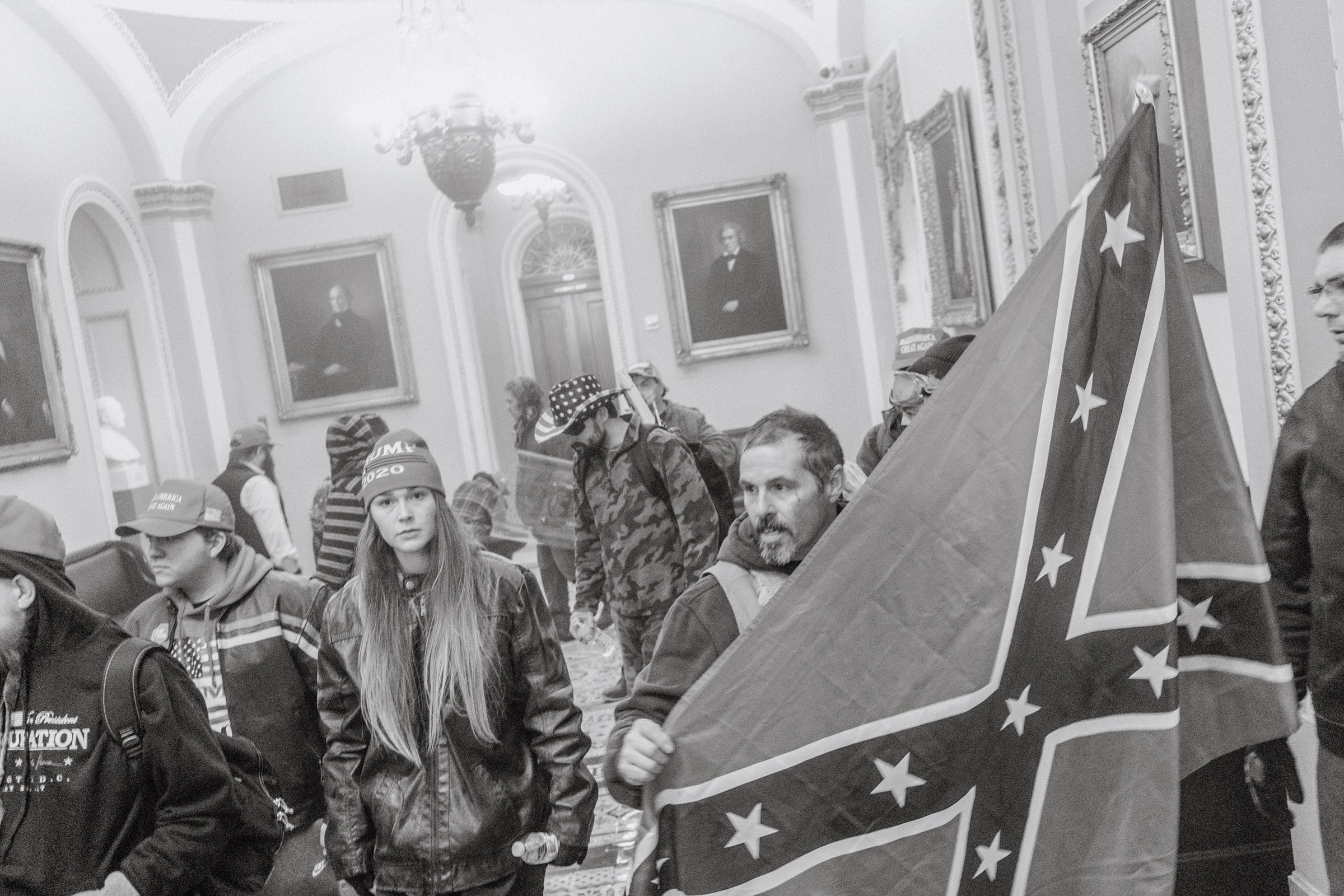
This was Ashli Babbitt’s crowd.
“We are walking to the Capitol in a mob. There’s an estimated over three million people here today,” the 35-year-old Californian announced to the viewers watching her video stream, narrating her journey along Pennsylvania Avenue on Jan. 6 with a group intent on stopping the certification of Joe Biden’s election. Babbitt wore a Trump flag as a cape. All around her, the slogans and chants seemed to have jumped the digital divide, echoing the Twitter feeds she prolifically shared. Babbitt sounded giddy about seeing the President speak in person that morning. “There is a sea of nothing but red, white and blue patriots for Trump,” she told viewers. “God bless America, patriots.”
Less than two hours later, Babbitt was fatally shot in the neck by Capitol Police as she tried to climb through a broken window into the Speaker’s Lobby, a chamber off the House of Representatives where lawmakers were sheltering from the angry throngs forcing their way into the building.
Her death was part of the grim toll of a riot that left five people dead, including a Capitol Police officer, vandalized the seat of American democracy and left the nation shaken. But the insurrectionists who stormed the Capitol with Babbitt—climbing on scaffolding, smashing windows, looting offices and posing for selfies as they romped through the building for nearly three hours—were far from chastened by the deadly cost. On pro-Trump forums and messaging apps, there was jubilation: “The 6th was a day to be proud of!” read one post on a pro-Trump board. “The most patriotic thing I ever witnessed,” wrote another. “This is only the beginning. Trump was the fuse, we are the bomb.”
The rampage at the Capitol was a demonstration of power that far-right extremists intend to wield as a recruiting tool, according to interviews with nine former U.S. security officials and experts who study right-wing extremism. “What happened Wednesday will provide source material for years and years of propaganda they’ll use in hopes of recruiting new individuals and inspiring further action,” says Jared Holt, who tracks far-right extremist groups at the Atlantic Council’s Digital Forensic Research Lab.
One of the keys to that propaganda, experts say, will be its new martyr: a young, white, 14-year Air Force veteran who liked to post photos in red MAGA hats and We Are Q shirts. Babbitt, who ran a pool-supply company with her husband in San Diego, was an avid Trump supporter who prolifically retweeted conspiracy theories and posted angry videos directed at lawmakers.
Regardless of what Babbitt believed in life, in death she has become a symbol both for causes she fervently embraced and some she likely never even heard of. On pro-Trump message boards, apps like Parler, and even more explicitly extremist corners of the Internet, she has been hailed since the riot as a “freedom fighter,” the “first victim of the second Civil War,” a patriot who was sacrificed in an imagined revolution. “The beautiful young woman who was executed will be remembered as a martyr,” one user wrote on a pro-Trump board. Another post was titled “Innocent girl – only wanted free and fair elections.” One poster vowed, “Your blood will not be in vain. We will avenge you.”
Babbitt’s emergence as a martyr for many of the different groups that made up the pro-Trump mob is no surprise. White women’s deaths have long been leveraged for propaganda, from the 19th century Klu Klux Klan to the militia movements of the 1990s to Donald Trump’s 2016 presidential campaign, which often invoked their killing at the hands of undocumented immigrants.
“Women are the tools that soften the edges of the far right,” says Seyward Darby, a journalist who researches the role of women in white-nationalist movements. For many of these groups, a white woman who is harmed or killed is the most powerful galvanizing force, Darby says. “They had been talking about how it’s a matter of life or death, but now they have an example. Are you a patriot? Are you a man? Avenge her death.”

Like many who assembled in D.C. on Jan. 6, Babbitt’s longtime enthusiasm for the President had recently gained a fanatical edge. A former fan of Barack Obama, she had ardently supported Trump since his 2016 campaign, posting defenses of his policies and criticizing lawmakers in her home state. In one furious monologue, recorded in her car in Nov. 2018, Babbitt blamed California politicians for “refusing to choose America” and criticizing Trump. “You can consider yourself put on notice by me and the American people,” she yelled into the camera. In another angry video, posted on Twitter a month later, she echoed Trump’s language on immigration. “The border is an absolute sh-t show,” she ranted. “There’s riots, there’s arrest, there’s rapes, there’s drugs.”
By 2020, she began to share an increasingly outlandish set of conspiracy theories, on topics ranging from the existence of deep-state cabals to COVID-19 vaccine skepticism to the baseless allegations of rampant voter fraud promoted by the President. Many of her tweets started to include popular QAnon hashtags.
Her radicalization online carried over into real life. Babbitt posted jubilant videos from a massive Trump boat parade in San Diego last September, wearing a We Are Q shirt. A sign at the door of her pool-supply business proclaimed it to be a “mask free autonomous zone, better known as America,” according to a photo published by the Associated Press.

In the final months of her life, Babbitt’s posts took on a biblical fervor, casting Trump’s supporters as warriors in an epic battle of good versus evil. Her last tweet, sent after she arrived in Washington on Jan. 5, read: “Nothing will stop us….they can try and try and try but the storm is here and it is descending upon DC in less than 24 hours….dark to light!” The reference to the “storm” is a key tenet of the QAnon conspiracy, the day adherents believe a violent reckoning will expose the deep state and bring Trump’s enemies to justice.
Babbitt’s personal journey, from run-of-the-mill Trump fan to radical conspiracist, has become a surprisingly common phenomenon. Pro-Trump conspiracies exploded in 2020, as COVID-19 shrank many Americans’ worlds to little more than the content on their screens. As the President raged against his enemies and lied about a rigged election, a broad cross-section of the political right—from ordinary Republicans to budding conspiracy theorists to hardened extremists—all spent months incubating in the same online environment, experts say. Finally they collided at a series of “Stop the Steal” rallies that culminated in the Jan. 6 events in D.C.
“The most salient thing for me is the degree to which your bread-and-butter GOP supporter, who fills out rallies and events, seem to be intermingling with extreme far-right factions: accelerationists, neo-Nazis, white nationalists, people who believe there is no political solution at all,” says Michael Hayden, an investigator at the Southern Poverty Law Center, which tracks militia and far-right extremist activity. On Jan. 6, Hayden says, it became apparent how much those “soft barriers” had collapsed, allowing extremists to leverage a larger crowd to carry out their own agenda, using shared outrage over the lie that the election had been stolen from them.
Babbitt’s death has bound them in a new common cause. “We need a round 2, NOW. We need to keep stoking this fire while it’s still burning,” one commenter wrote on a pro-Trump forum that had served as a staging ground for the Jan. 6 rally. “We need to take everyone’s anger over the election, our government, and the murder of the young woman, and turn it into action.”

Within hours of her death, Babbitt’s canonization began. In thousands of posts on pro-Trump forums, digital memorials and photo tributes lauded her as a hero for the movement. One popular meme showed a police officer giving demonic Black Lives Matter protestors a pass for torching cities, while telling Babbitt—portrayed in a demure flowered dress and a red MAGA hat—that it’s “time to die.” Many posts used the hashtag #SayHerName, which trended on Twitter and Parler, co-opting a campaign meant to call attention to police violence against Black women.
“This if nothing else should galvanize and emboldened women,” Kira Innis, 34, a Black conservative activist from Los Angeles who attended the rally, says of Babbitt’s death. “This needs to be a rallying cry to say we are standing stronger behind Trump, more so than we’ve ever done before. This should embolden the patriots.”
Already, Babbitt’s death is becoming a rallying cry capable of uniting the maze of factions and ideologies that converged for the Capitol riot. Many of them cite her death as evidence of what they say brought them to D.C. in the first place: a corrupt U.S. government occupied by nefarious forces seeking to suppress and destroy Trump supporters. Groups are citing the same event to shape different narratives and designating a different enemy.
“The more MAGA types want to place [blame] at the feet of the government: the state killed a patriot,” says Megan Squire, a professor of computer science at Elon University who tracks online extremism. On more hardened extremist forums, “terror types are hoping it’s a Black police officer, or Jewish, or some other hated minority” who shot Babbitt in order to inflame racial tensions, she says. Squire believes that it’s a third group—those who sympathized with the anger that spurred the insurrection at the Capitol, but were turned off by the violence—for whom Babbitt may become the most powerful symbol in recruitment campaigns.
Those campaigns are already underway. “Immediately you saw the traffic online with people praising what was done,” says Elizabeth Neumann, who resigned last year from leading the Department of Homeland Security office that oversees responses to violent extremism. “They see it as a sign that the civil war is coming.”
Since Wednesday, posts in right-wing spaces have had titles like “Storm the Inauguration – We are Now Under Occupation” and “Ashli is just a speed bump as we turn back the tide of White genocide.”

The start of a new Democratic Administration is historically a time of increased activity for the far-right. Extremist right-wing groups saw their numbers jump by more than 250% in the first year of Barack Obama’s presidency, according to a 2010 report by the Southern Poverty Law Center. “As Democrats come into power, these groups historically get more paranoid about gun restrictions, minority rights, not to mention now the COVID-related lockdowns,” says Daryl Johnson, a former senior analyst at the Department of Homeland Security who authored a controversial 2009 report warning of the dangers of ignoring the rising threat of far-right extremism.
Now many of these groups are pointing to Babbitt’s death as cause for further action. Some say they are already planning a “Million Martyr March” on Jan. 20 in D.C. Designs for a black, red and white “battle flag” honoring Babbitt, which originated on the message board 4chan, show the outline of a woman with long hair, framed by the backdrop of the Capitol and a large drop of red blood—a design which evokes the insignia of the KKK and the color scheme of fascist symbols. It has been widely shared, including by the pro-Trump lawyer turned-turned-conspiracy-theorist Lin Wood.
“Mark my words,” Johnson warns. “This woman will be used as a martyr figure to inspire others to radicalize towards violence.”
With reporting by W.J. Hennigan and Kim Dozier/Washington and Francesca Trianni/Gainesville
More Must-Reads from TIME
- Cybersecurity Experts Are Sounding the Alarm on DOGE
- Meet the 2025 Women of the Year
- The Harsh Truth About Disability Inclusion
- Why Do More Young Adults Have Cancer?
- Colman Domingo Leads With Radical Love
- How to Get Better at Doing Things Alone
- Michelle Zauner Stares Down the Darkness
Write to Vera Bergengruen at vera.bergengruen@time.com